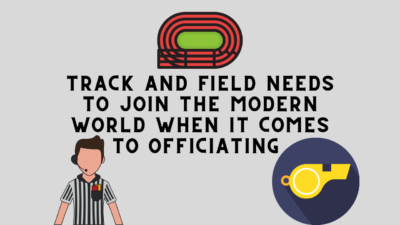World Athletics’ Rule Changes Are A Step In The Right Direction, But…
By Robert Johnson
November 3, 2021
For a long while, we at LetsRun.com have been complaining about the rules of track and field. They are too draconian. The rule book leaves nothing open to a referee’s discretion. Generally, if you violate the rules, the only option in the rule book is disqualification.
That’s ridiculous.
I’ve long argued that stepping on the line in the beginning of a distance race shouldn’t result in disqualification, nor should grazing the curved line between lanes in the midst of a 400.
Five years ago, I wrote that the French should be ashamed of themselves for getting Ezekiel Kemboi DQ’d from the Olympics for stepping on the line after the second water jump more than a mile from the finish in the 3,000-meter steeplechase.
In 2018, after an entire heat of competitors at World Indoors were DQ’d for stepping on the line in a 400, LetsRun.com formally called on World Athletics to change the rule books:
In 2020, after Brigid Kosgei got DQ’d for stepping on the rail one time in an hour-long race, we again called for the rule to be changed.
I’ve got good news to report. I won’t be rewriting a slightly different version of the same column over and over for the rest of my life. On Monday, World Athletics officially announced that they’ve changed their rules regarding lane infringement. One step on or over the line/kerb in a distance race won’t result in a DQ anymore. Two steps are required to result in a DQ.
Similarly, if you step on the line once in a 200 or 400, you aren’t DQ’d either (you’re still DQ’d if you step completely over the line).
🚨COMPETITION RULE CHANGE🚨
Lane infringement updates among recent competition rule changes now in force.
— World Athletics (@WorldAthletics) November 1, 2021
I can quibble over whether that’s the way I would have written the rule. (It’s not — instituting a time penalty would be better. I’m still worried about an athlete who takes one misstep on top of the rail, loses their balance, and then takes one step on the infield. Under the new rules, that would still be a DQ, even though it shouldn’t be. In the NFL if pass is uncatchable, they don’t call pass interference. In track, if an infraction has zero bearing on the outcome, it similarly shouldn’t be called) But the changes are a big improvement. Thank you.
Now, let’s don’t stop there.
More changes still need to be made. In Tokyo this year, what was even more frustrating than the draconian rules was World Athletics’ total lack of transparency about why certain rule decisions were made and the slowness in those decisions being made.
It’s important that World Athletics realize they are putting on a sporting event meant to entertain millions across the globe. Both the athletes and fans need to be told when and why rules decisions are made and it needs to be done in a timely fashion.
At the Olympics, Francine Niyonsaba was DQ’d for allegedly stepping on the rail in the women’s 5000 heats. When the race was over, no one even knew the race was under review. When the DQ came out, there was no formal announcement made by a referee like you’d see in a normal sporting event. No, the DQ just popped up on the results screen and we, the journalists, were forced to break the news to Niyonsaba. That’s ridiculous.
Similarly, after American Isaiah Jewett was taken out from behind by Nijel Amos in the men’s 800 semifinals, no satisfying explanation was ever given as to why Amos, but not Jewett, was placed in the final.
I repeatedly asked World Athletics for an explanation for why these decisions were made and to be shown the race video used to make those decisions. Not only did World Athletics repeatedly refuse to do so, they even went as far as to tell me they weren’t the video rights holder and therefore couldn’t show me the video. Please. Both journalists and fans can be shown video under fair use doctrine.
Moving forward, the fans (and athletes) need to know if a race is under review before the athletes step off the track. The review should be done publicly like it is in other sports, whether it’s the NFL or Premier League, and then announced to the crowd within a matter of minutes just like it is in the major sports leagues. Having jury of appeals meet clandestinely without ever having to explain themselves is beyond antiquated. It’s time to hire a public-facing meet referee or referees for the biggest events.
The way the current system works is horrible for everyone – athletes, fans, journalists and tv partners. No one would tolerate it if the outcome of a soccer match was overturned via VAR 45 minutes after it was over without explanation. Yet this routinely happens in track and field.
What do you think? Share your opinions on the LetsRun.com’s world-famous fan forum/messageboard. MB: Rojo: Track and field needs to join the modern world when it comes to officiating
Robert Johnson is the co-founder of LetsRun.com. A long time ago, he ran a 2:23 marathon and helped guide Catherine Ndereba to the women’s marathon world record.

